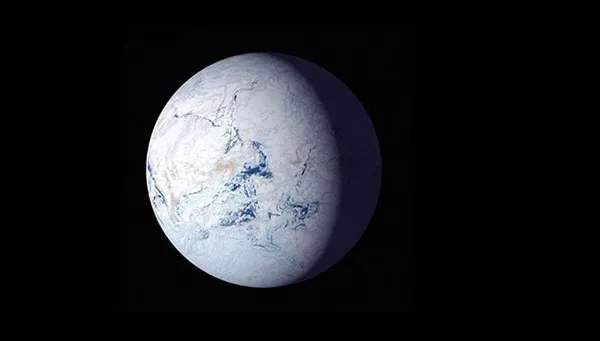In the ongoing debate over the potential cause of ancient deep freeze events that occurred across the planet, a research team led by Yale has taken a stand in the “Snowball Earth” scenario.
A recent study suggests that massive asteroids striking Earth in an abrupt manner may have caused these so-called “Snowball” Earth periods, during which the planet’s surface was blanketed in ice for thousands or even millions of years.
The research, which is published in the journal Science Advances, may provide an explanation for some of the most notable known climate shifts in Earth’s history, which has baffled scientists for decades. Researchers from the University of and the University of Vienna were involved in the study in addition to Yale.
Since the 1960s, climate scientists have been aware that if the Earth got cold enough, the high reflectivity of its snow and ice could start a “runaway” feedback loop that would increase the amount of sea ice on the surface and cause temperatures to drop until the entire planet was covered in ice. Between 720 and 635 million years ago, during Earth’s Neoproterozoic era, such circumstances transpired at least twice.
However, research into the causes of these worldwide glacial periods—dubbed “Snowball Earth” events—has yielded conflicting results. The idea that greenhouse gases in the atmosphere somehow decreased to the point where “snowballing” started has been the core of the majority of theories.
Lead author and Richard Foster Flint Postdoctoral Fellow Minmin Fu of Yale’s Faculty of Arts and Sciences’ Department of Earth and Planetary Sciences stated, “We decided to explore an alternative possibility.” “What if this sudden shift in climate change was caused by an alien influence?”
A complex climate model that simulates atmospheric and oceanic circulation as well as sea ice formation under various scenarios was employed by the researchers for the study. Future climate scenarios are predicted using the same kind of climate model.
Here, the model was used to simulate the effects of a hypothetical asteroid strike in four different historical eras: preindustrial (150 years ago), Cretaceous (145–66 million years ago), Last Glacial Maximum (21,000 years ago), and Neoproterozoic (1 billion to 542 million years ago).
In the case of the Cretaceous and preindustrial warmer climate scenarios, the researchers concluded that there was little chance of an asteroid impact causing worldwide glaciation. However, in the case of the Last Glacial Maximum and Neoproterozoic eras, when the planet may have already experienced an ice age, an asteroid impact could have caused Earth to enter a “snowball” phase.
“The finding that a ‘Snowball’ state following an asteroid impact can form over the entire ocean in less than ten years, given sufficiently cold initial climate conditions is what most surprised me about our results,” co-author Alexey Fedorov, a professor of ocean and atmospheric sciences at Yale’s Faculty of Arts and Sciences, said. By that time, the sea ice at the Equator would be roughly ten meters thick. This should be contrasted with the one to three meters of sea ice that is typically present in the Arctic today.
Though other impacts could be just as destructive, the researchers said that the likelihood of an asteroid-induced “Snowball Earth” period in the years to come was low, partly because of global warming brought on by human activity.
The ARCHANGE project and the Yale Flint Postdoctoral Fellowship provided funding for the research. Christian Koeberl of the University of Vienna and Dorian Abbot of the University of are the study’s co-authors.


